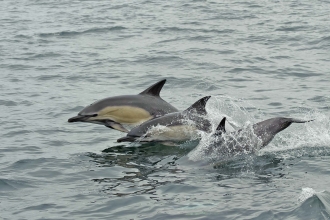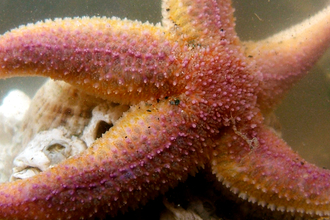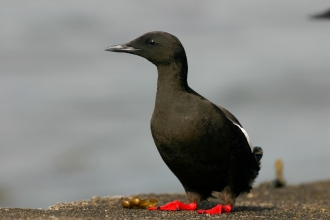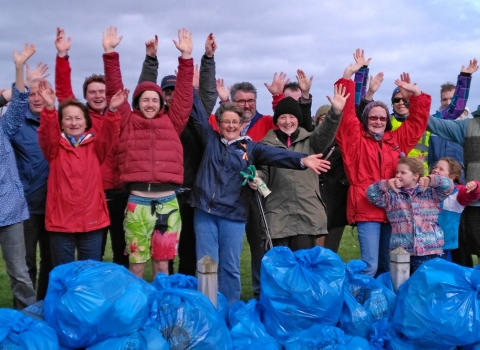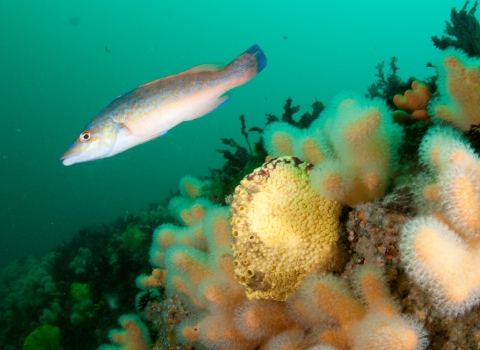Take a dip below the waves
No matter where you are in Northern Ireland, you are never more than 35 miles from the sea. Our seas are home to a vast array of magnificent marine life, small and big, from mussels to minke whales, scallops to skates, and brittle stars to basking sharks.
Dip below the surface using our interactive map and discover more about the amazing sea life that calls our local waters home.

(Cetorhinus maximus)

The second largest fish in the world weighing in at around 7 tonnes and measuring up to 12 metres, the basking shark is a summer visitor to Northern Irish waters. Basking sharks swim with their mouths wide-open to eat small shrimp-like creatures (plankton) in the seawater.

(Cetorhinus maximus)

The second largest fish in the world weighing in at around 7 tonnes and measuring up to 12 metres, the basking shark is a summer visitor to Northern Irish waters. Basking sharks swim with their mouths wide-open to eat small shrimp-like creatures (plankton) in the seawater.

(Cetorhinus maximus)

The second largest fish in the world weighing in at around 7 tonnes and measuring up to 12 metres, the basking shark is a summer visitor to Northern Irish waters. Basking sharks swim with their mouths wide-open to eat small shrimp-like creatures (plankton) in the seawater.

(Ostrea edulis)

Oysters are a type of edible shellfish. All native oysters start out as males, and throughout their lives change back and forth from male to female. A single female oyster can produce 2 million eggs. Native oysters can be found from the shore down to a depth of 80m on almost any type of seabed from bedrock to mud.

(Ostrea edulis)

Oysters are a type of edible shellfish. All native oysters start out as males, and throughout their lives change back and forth from male to female. A single female oyster can produce 2 million eggs. Native oysters can be found from the shore down to a depth of 80m on almost any type of seabed from bedrock to mud.

(Ostrea edulis)

Oysters are a type of edible shellfish. All native oysters start out as males, and throughout their lives change back and forth from male to female. A single female oyster can produce 2 million eggs. Native oysters can be found from the shore down to a depth of 80m on almost any type of seabed from bedrock to mud.

(Ostrea edulis)

Oysters are a type of edible shellfish. All native oysters start out as males, and throughout their lives change back and forth from male to female. A single female oyster can produce 2 million eggs. Native oysters can be found from the shore down to a depth of 80m on almost any type of seabed from bedrock to mud.

(Phocoena phocoena)

The Harbour porpoise is a secretive animal that reveals little of itself at the surface. When feeding or swimming fast it can leave the water so quickly that it is extremely difficult to see. The Harbour porpoise can be found all along the Northern Irish coast, up to 6 miles inland.

(Phocoena phocoena)

The Harbour porpoise is a secretive animal that reveals little of itself at the surface. When feeding or swimming fast it can leave the water so quickly that it is extremely difficult to see. The Harbour porpoise can be found all along the Northern Irish coast, up to 6 miles inland.


Rocky reefs are home to a variety of creatures from soft corals like "dead mans fingers" to colourful sponges and seaweeds. They are a place where creatures can attach to the rocks and many young fish hide in the crevices between the rocks and boulders.


Rocky reefs are home to a variety of creatures from soft corals like "dead mans fingers" to colourful sponges and seaweeds. They are a place where creatures can attach to the rocks and many young fish hide in the crevices between the rocks and boulders.


Rocky reefs are home to a variety of creatures from soft corals like "dead mans fingers" to colourful sponges and seaweeds. They are a place where creatures can attach to the rocks and many young fish hide in the crevices between the rocks and boulders.


Brittlestars are related to starfish and some species form dense beds consisting of millions of individuals. These brittlestar beds occur usually in places with fairly strong tidal currents because they are catching tiny food particles out of the water (filter feeding)


Brittlestars are related to starfish and some species form dense beds consisting of millions of individuals. These brittlestar beds occur usually in places with fairly strong tidal currents because they are catching tiny food particles out of the water (filter feeding)


Brittlestars are related to starfish and some species form dense beds consisting of millions of individuals. These brittlestar beds occur usually in places with fairly strong tidal currents because they are catching tiny food particles out of the water (filter feeding)


Northern Ireland has two species of seal Common Seal (Phoca vitulina) and Grey Seal (Halichoerus grypus). Both spend much of their time at sea, but come ashore to breed. They can sometimes be difficult to tell apart, But grey seals have a very distinctive face, and the scientific name –Halichoerus grypus – actually means 'sea-pig with a hooked nose'. Grey seals are also larger than common seals, and the males in particular tend to be a more uniform colour while common seals are often covered in spots..


Northern Ireland has two species of seal Common Seal (Phoca vitulina) and Grey Seal (Halichoerus grypus). Both spend much of their time at sea, but come ashore to breed. They can sometimes be difficult to tell apart, But grey seals have a very distinctive face, and the scientific name –Halichoerus grypus – actually means 'sea-pig with a hooked nose'. Grey seals are also larger than common seals, and the males in particular tend to be a more uniform colour while common seals are often covered in spots..


Northern Ireland has two species of seal Common Seal (Phoca vitulina) and Grey Seal (Halichoerus grypus). Both spend much of their time at sea, but come ashore to breed. They can sometimes be difficult to tell apart, But grey seals have a very distinctive face, and the scientific name –Halichoerus grypus – actually means 'sea-pig with a hooked nose'. Grey seals are also larger than common seals, and the males in particular tend to be a more uniform colour while common seals are often covered in spots..


Northern Ireland has two species of seal Common Seal (Phoca vitulina) and Grey Seal (Halichoerus grypus). Both spend much of their time at sea, but come ashore to breed. They can sometimes be difficult to tell apart, But grey seals have a very distinctive face, and the scientific name –Halichoerus grypus – actually means 'sea-pig with a hooked nose'. Grey seals are also larger than common seals, and the males in particular tend to be a more uniform colour while common seals are often covered in spots..


Northern Ireland has two species of seal Common Seal (Phoca vitulina) and Grey Seal (Halichoerus grypus). Both spend much of their time at sea, but come ashore to breed. They can sometimes be difficult to tell apart, But grey seals have a very distinctive face, and the scientific name –Halichoerus grypus – actually means 'sea-pig with a hooked nose'. Grey seals are also larger than common seals, and the males in particular tend to be a more uniform colour while common seals are often covered in spots..


There are about 65 species of crab in the waters of the British Isles. Some of the most important for fisheries are the brown crab Cancer pagurus swimming crabs such as the velvet swimming crab Necora puber and the spider crab Maja brachydactyla which is a newcomer to our shores and is likely to become more frequent if the waters get warmer around Northern Ireland.


Northern Ireland has some amazing sea caves, especially around Rathlin Island, and the Skerries and Causeway Coast. Underwater caves at Rathlin occur mainly at depths ranging from 20 to over 100 m and are home to a variety of creatures including sponges which are unique to Rathlin.

(Fratercula arctica)

The puffins of Northern Ireland are to be found on Rathlin Island. The puffin is a monogamous bird which breeds for life and lives in larger colonies, the largest on record numbers 260,000. They feed mostly on small fish which they will carry back to their young. Unlike other birds they will nest in burrows. The puffin's colourful beaks are only present during the breeding season.


Maerl is a collective term for several species of red seaweed, with hard, chalky skeletons. It is rock hard and, unlike other seaweeds, it grows as unattached rounded nodules or short, branched shapes on the seabed. Like all seaweeds, maerl needs sunlight to grow, and it only occurs to a depth of about 20m where it provides a home for many other creatures.


Maerl is a collective term for several species of red seaweed, with hard, chalky skeletons. It is rock hard and, unlike other seaweeds, it grows as unattached rounded nodules or short, branched shapes on the seabed. Like all seaweeds, maerl needs sunlight to grow, and it only occurs to a depth of about 20m where it provides a home for many other creatures.


Maerl is a collective term for several species of red seaweed, with hard, chalky skeletons. It is rock hard and, unlike other seaweeds, it grows as unattached rounded nodules or short, branched shapes on the seabed. Like all seaweeds, maerl needs sunlight to grow, and it only occurs to a depth of about 20m where it provides a home for many other creatures.

(Atrina fragilis)

These are the largest living seashell in our waters reaching an impressive 30cm long. They are very rare with the last live one seen in 2007 off Rathlin Island and recently a few younger empty shells were found near the Skerries on the north coast.

(Nephrops norvegicus)

The Dublin Bay prawn also known as the langoustine is a relative of the lobster, though it is smaller and slimmer. The claws are spiked and are as long as the body. They can live up to depths of 40m in burrows and hunt other small crustaceans. Generally they can be found in the waters to the south east of Northern Ireland.

(Nephrops norvegicus)

The Dublin Bay prawn also known as the langoustine is a relative of the lobster, though it is smaller and slimmer. The claws are spiked and are as long as the body. They can live up to depths of 40m in burrows and hunt other small crustaceans. Generally they can be found in the waters to the south east of Northern Ireland.

(Nephrops norvegicus)

The Dublin Bay prawn also known as the langoustine is a relative of the lobster, though it is smaller and slimmer. The claws are spiked and are as long as the body. They can live up to depths of 40m in burrows and hunt other small crustaceans. Generally they can be found in the waters to the south east of Northern Ireland.


Kelps are tall brown seaweeds which grow on underwater rocks from the bottom of the shore to shallow waters down to 30m deep if the waters are clear, forming dense underwater forests, which are just as valuable for wildlife as woodlands on land.


Seagrass (sometimes called eelgrass) are one of the few flowering plants which live on the shore and in our shallow seas. They can form extensive beds which are like the meadows of the sea and many creatures depend on them for food such as the light-belied brent geese which visit Strangford Lough. There are other fish, crabs and shellfish living in the underwater seagrass beds.

(Mola mola)

The ocean sun fish or mola, is the heaviest known bony fish in the world and can reach 3m in length. They live in the Atlantic and Pacific oceans and mainly eat jellyfish which are low in nutrients so they must eat vast amounts in order to survive.

(Dermochelys coriacea)

Leatherback turtles can weigh up to a tonne and reach almost three metres in length, August is the peak time to be lucky enough to see leatherback turtles, as they arrive from their nesting grounds in the Caribbean to refuel on our abundant seasonal jellyfish blooms.


Jellyfish are becoming more frequent visitors to our local waters. There are a few which you may commonly see including the moon jelly (Aurelia aurita), which is small and clear with four purplish rings on the top, and the Lions Mane (Cyanea capillata), which can be as big as a dustbin lid with long orange tentacles.


We have a variety of different dolphin's that visit our local waters including the common dolphin (Delphinus delphis), the bottlenose dolphin (Tursiops truncatus) and risso's dolphin (Grampus griseus). They use echolocation to search for prey, similar to sonar, they emit clicking sounds and listen for the return echoes to locate the whereabouts of potential prey.


We have a variety of different dolphin's that visit our local waters including the common dolphin (Delphinus delphis), the bottlenose dolphin (Tursiops truncatus) and risso's dolphin (Grampus griseus). They use echolocation to search for prey, similar to sonar, they emit clicking sounds and listen for the return echoes to locate the whereabouts of potential prey.


Skates and rays are flat cartilaginous (their skeletons are made of cartilage rather than bone) fish, which are related to sharks. They are long lived (Common Skate can live to be over 100 years old) and they feed on creatures on the sea bed.

(Pecten maximus)

King scallops have unique shells in that each half of the shell is a different shape. The upper half is curved, while the lower is straight. The scallops swim by rapidly snapping their shells to propel them through the water. We also have Queen scallops (Aequipecten opercularis) in our waters which are smaller.

(Pecten maximus)

King scallops have unique shells in that each half of the shell is a different shape. The upper half is curved, while the lower is straight. The scallops swim by rapidly snapping their shells to propel them through the water. We also have Queen scallops (Aequipecten opercularis) in our waters which are smaller.

(Puffinus puffinus)

Manx shearwaters were previously known as puffins, they share the same nesting habits as the other species which includes nesting in burrows. The bird gains its name from its typical manner of flight which entails flying low across the water on stiff wings with few wingbeats.

(Modiolus modiolus)

The horse mussel has a bulky appearance, it often lives in mud or surrounded by stones so that only the end of the shell from which water can enter and exit is visible. They anchor themselves to the seafloor and thereby stabilises itself so that a type of reef is formed. Other creatures like sea squirts often live on the mussels shell.

(Modiolus modiolus)

The horse mussel has a bulky appearance, it often lives in mud or surrounded by stones so that only the end of the shell from which water can enter and exit is visible. They anchor themselves to the seafloor and thereby stabilises itself so that a type of reef is formed. Other creatures like sea squirts often live on the mussels shell.

(Orcinus orca)

The orca also known as the killer whale is the largest member of the dolphin family at up to 9 metres in length. They live in close knit family groups called pods and can be found at times along the eastern coast and have even been spotted in Lough Foyle.

(Virgularia mirabilis)

Sea pens are feather-shaped colonies of anemone-like animals that are related to soft corals. Sea pens are adapted to life on muddy or sandy sea beds where they anchor themselves so that they can filter-feed. They can be found off the coast of Co. Down.

(Virgularia mirabilis)

Sea pens are feather-shaped colonies of anemone-like animals that are related to soft corals. Sea pens are adapted to life on muddy or sandy sea beds where they anchor themselves so that they can filter-feed. They can be found off the coast of Co. Down.

(Virgularia mirabilis)

Sea pens are feather-shaped colonies of anemone-like animals that are related to soft corals. Sea pens are adapted to life on muddy or sandy sea beds where they anchor themselves so that they can filter-feed. They can be found off the coast of Co. Down.


Flat fish are frequently found on muddy or sandy sea beds. Flat fish are frequently found on muddy or sandy sea beds. When Flat fish hatch they look like 'normal' fish with an upright position and an eye on each side, however as they develop they appear more and more twisted until the conventional flat form is reached.

(Alca torda)

Razorbills are colonial seabirds that mate for life. Females will lay one egg each year and nest along coastal cliffs. They can be found along the North Antrim coast, where they hunt fish by diving into the water and using their streamlined wings to propel them deeper, they can reach depths of 120 metres.

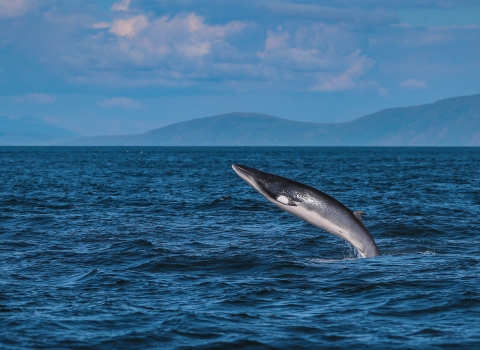
 Play Video
Play Video View Gallery
View Gallery
